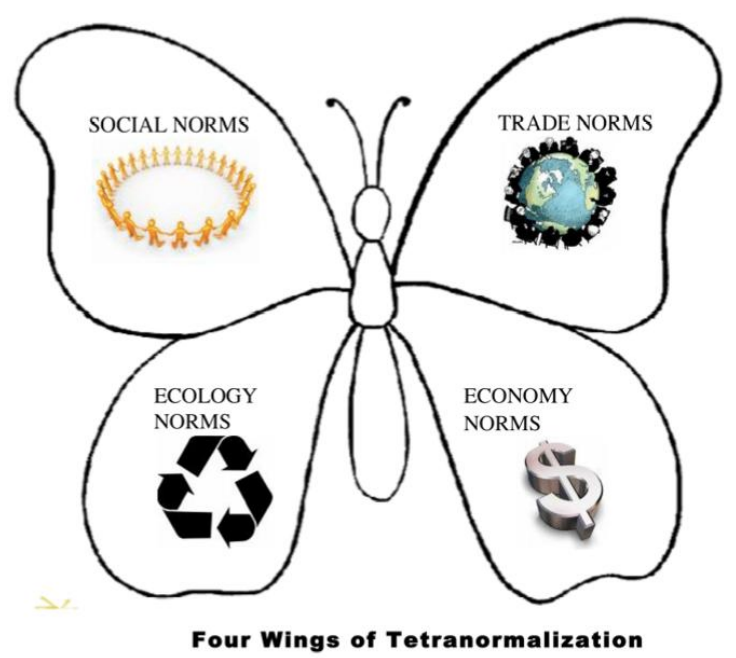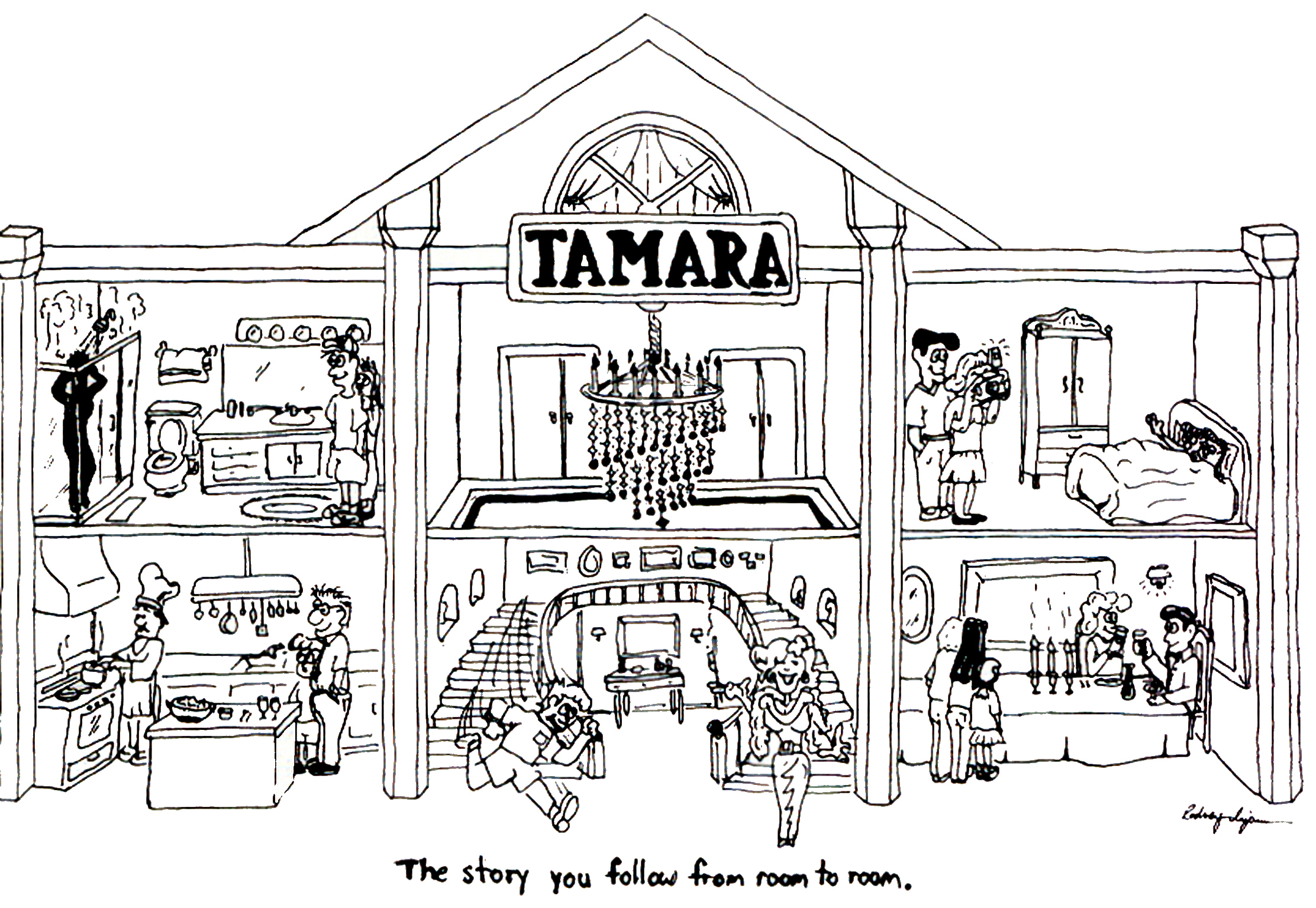Organizational Research Methods: Storytelling in ActionDavid M. Boje Book being prepared for Routledge, due March 2018 To cite this document: Boje, David M. (2018) "Organizational Research Methods: Storytelling In Action", (March 15), URL = <https://davidboje.com/ORM_Storytelling_in_Action_Book/index> |
Chapter - RPO6 - Bruno Latour' Actor Network Theory
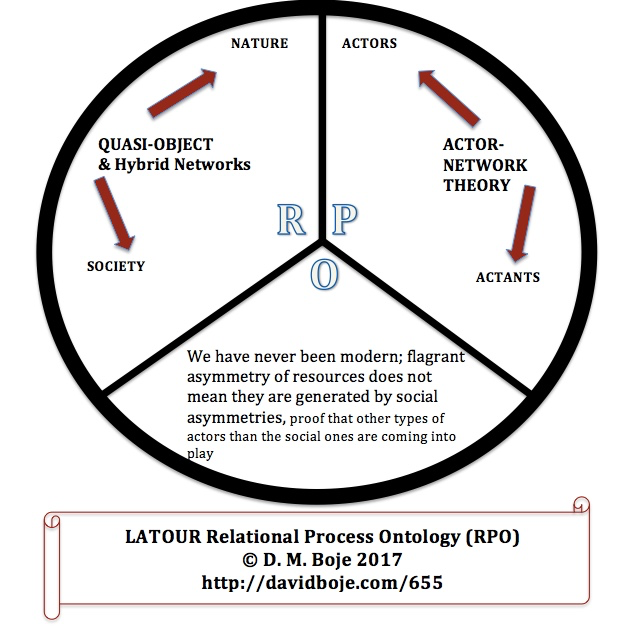
Figure 1: Relational Process Ontology of Latour Actor Network Theory of symmetry and Asymmetries (© D. M. Boje 2017).
BE the 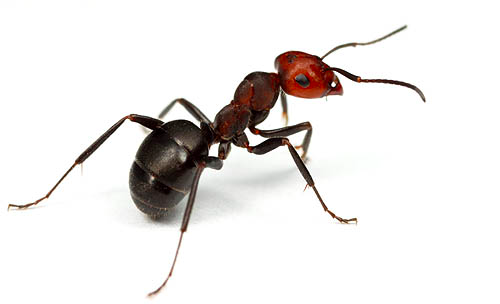 in doing ONTOLOGY of Actor-Actant-Network methdoloogy by Being-in-the-World, moving in ANT-World
in doing ONTOLOGY of Actor-Actant-Network methdoloogy by Being-in-the-World, moving in ANT-World

I was fortunate to be at Bruno Latour's keynote at the EGOS conference July 6, 1993 in Paris. He sat on the stage in his chair, with no notes. He said, "you have a story of what I am, and what I will do today." I could not believe it, someone else in the world understood how story is situated in context of relational process (sociological & historical) context of performance. I was blown away. The audience's story of Latour would dispatch his performance role on stage. "You have a story plot of what I will tell you today." And Latour was refusing to to be a story passage-point. Latour, then said, 'this is the first time I have been invited to address a conference in Paris." The ballroom exploded, French and other European, American and Australian members began to stand up, and arguments broke out everywhere. Pandemonium! A struggle between multiple discourses broke out in the audience, as Latour sat calmly on his chair. "Is this true?" "Certainly Latour has not been overlooked by the French Academy!" "Why are their only men introducing Latour and the conference?" It was an 'organizational learning situation: and the performance by Latour and EGOS, did unfold in TamaraLand (see TamaraLand article). It was a time when my 1991 Administrative Science Quarterly office supply article on 'storytelling organization' was not yet in print, and I had a piece in review at Academy of Management Journal on Disney-as-TamaraLand, an elaboration of what I had written about in an undergraduate textbook (Boje & Dennehy, 1993/2008: This one event impacted me so much I wrote about it, and it was published. Boje, D.M. 1994. "Organizational Storytelling: The Struggles of Pre-modern, Modern & Postmodern Organizational Learning Discourses, Management Learning Journal, Vol. 25 (3): 433-461. DOWNLOAD PDF Here is a bit of what I wrote on Latour's storytelling approach (p. 438).
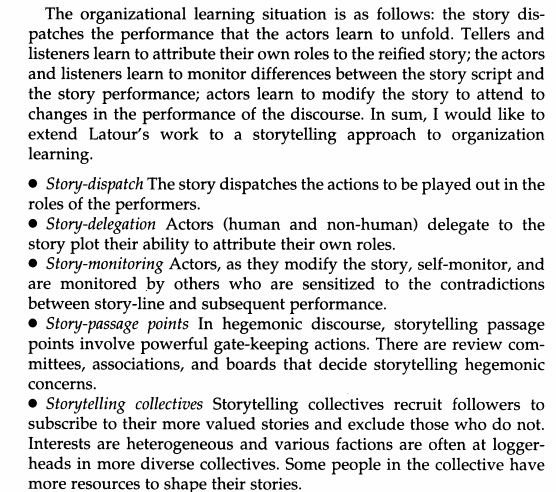
above is p. 438 in Boje (1994).
By way of tranition from Heidegger to Latour Actor Network Theory [ANT] (as well as Serres, Law and others) we can look at the spatiality, the distance and directionality:
"Thus closeness, in Latour as in Heidegger, does not come without directionality, because to be formatted is to exist for an association. Understanding ANT in these spatial terms is another way to understand why and how Latour rejects all variations on subject/object dialectics to explain what ANT is about and refuses to be trapped into Humeian/ Kantian/Science Wars’ questions about whether external reality exists – none of these ways of posing the question have any genuine place for the irreducible categories of being-in-place that are constitutive of ANT spatiality" (p. 480). Oppenheim, R. (2007). Actor-network theory and anthropology after science, technology, and society. Anthropological Theory, 7(4), 471-493. see searchable pdf.
WE HAVE NEVER been MODERN
Bruno Latour has changed out study of Plato-Hegel-Marx-Folett-Heidegger dialectics onto a new path! The three critical paths of the postmodern (poststructuralist) ways try to move us BEYOND MODERN, but WE HAVE NEVER been MODERN in the way the 3 poststructualist/potmodernist criticisms tell the story (p. 11 in Latour (1991/1993).
- NATURALISM, the path of Wilsom where discourse vanishes in repetition of divisions of history (p. 5-6, 59
- SOCIALIZATON the path of Bourdieu where science, technology and texts disappear
- DECONSTRUCTION the path of Derrida where brain neuron science disappears
PLEASE ORDER THIS BOOK form LIBRARY--> Latour, B. (1991 Freench/1993 English/2012 edition). We have never been modern. Harvard University Press.and for now see on line free pdf pp.5-6 for the 3 critical paths of poststructuralists and postmoderns:
Latour would not like to be called a dialectician. Nevertheless he does address the dualities that dialectic has tried (but failed) to overcome.
- FIRST DUALITY is what Barad (2007) would call agential cut between NON-HUMAN NATURE and HUMAN CULTURES. This sets up two artifical ontological zones in the Work of Purification of going Modern.
- SECOND DUALITY: The HYBRID NETWORKS in the Work of Translation in going Modern (p. 11).
"No one has ever been modern. Modernity has never begun" (p. 47).Instead there are cyborg, monsters, hybrids and tricksters called quasi-object, quasi-subject, and quasi-standard (p. 47, 52, 58).
GENERALIZED SYMMETRY - My interpretation of Latour is that he makes a move on the dialectic of Hegel (p. 52) and Heidegger (p. 65-67) by going back to Heraclitus (system=> all things are one, in some sense. Opposites are necessary for life, but they are unified in a system of balanced exchanges with an ongoing process governed by a law of change, in which you can not step in the same water of the river, twice). "Yes Heraclitus is a surer guide than Heidegger" (p. 67).
FIRST PRINCIPLE OF SYMMETRY This is my own interpretation: Deviations, error in the straight and narrow path of reason in symmetry of history (historicality) is a dialectic of continuity.
HOW TO END ASYMMETRY? The contemporary sociotechnical systems theory and its existential Being can be paired with quasi-object. "Sociotechnical networks" of ACTOR NETWORK THEORY "we discover tretrospectively, that we have never been truly modern" (p. 91).
FOUNDING PRINCIPLE OF ASYMMETRY OF THE 3 CRITICAL PATHS (Naturalism, Socialization, & Deconstruction). The gross asymmetry is the Cartesian duality, the split between Nature and Society. And is quasi-object that can restore symmetry. e.g. The quest to remove ideology of science makes quasi-objects invisible, reducing history (historicality) to science and its a science devoid of myth, to eliminate the madyess of error, false science paths (p. 93).
"Reassembling the Social, Latour writes:
"There is no empirical case where the existence of two coherent and homogenous aggregates, for instance technology ‘and’ society, could make any sense. ANT is not, I repeat is not, the establishment of some absurd ‘symmetry between humans and non-humans’. To be symmetric, for us, simply means not to impose a priori some spurious asymmetry among human intentional action and a material world of causal relations. There are divisions one should never try to bypass, to go beyond, to try to overcome dialectically. They should rather be ignored and left to their own devices, like a once formidable castle now in ruins. (76)
In a footnote to the passage, he adds:
"This is the reason why I have abandoned most of the geometrical metaphor about the ‘principle of symmetry’ when I realized that readers concluded from it that nature and society had to be ‘maintained together’ so as to study ‘symmetrically’ ‘objects’ and ‘subjects’, ‘non-humans’ and ‘humans’. But what I had in mind was not and, but neither: a joint dissolution of both collectors. The last thing I wanted was to give nature and society a new lease on life through ‘symmetry’. (76)
In sum, Latour's dialectic move, in my read, is to reject separation between Nature and Society, and the belief in modernith. He retains long actor-actant networks, multiple times, and spaces in which qusi-objects proliferate.
At this point in the systems course, you will begin to see how open systems theory, socio technical systems theory, etc. are forming hybrid theory relations with Bruno Latour's Actor Network Theory that combines the social actors with the material actants (actors) in sociomaterial systems understanding, that Barad, Brier (who combines Peirce-semiotics & Luhmann's Autopoietic systems), my own work, and others we shall study build upon. ANT is a major turn in systems theory because it moves us beyond the abstract static models of open systems, and challenges the social constructivist paradigm, which privileges language and eschews materiality. You will need to study Autopoietic systems (see Noe, E., & Alroe, below). Latour says there is no 'social' and no 'construction understanding in 'social constructivism' and that it leaves out the 'materiality.' For me, this quote sums up Latour's frustration with social constructivism (which by the way is basis of 3rd wave Grounded Theory).
STORYTELLING-IN-ACTION, AND A GOOD 'ANT' ACCOUNT: "To put it very simply: A good ANT account is a narrative or a description or a proposition where all the actors do something and don’t just sit there. Instead of simply transporting effects without transforming them, each of the points in the text may become a bifurcation, an event, or the origin of a new translation” (Latour, 1998/2005, p.128).

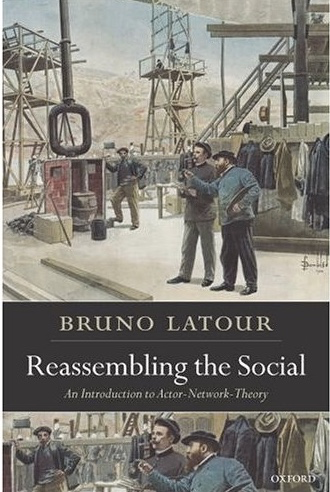
Start Here -STEP 1: Why is Latour writing against social constructivism?-Answer, Latour is putting the 'materiality' back into social materiality, that social constructivism had removed.
Please read his seminal online book, Latour, Bruno. Reassembling The Social: An introduction to Actor Network Theory (1998/2005) http://dss-edit.com/plug/Latour_Reassembling.pdf (downloadable for free).
For beginning intro to ANT see Law, J. (1992). Notes on the theory of the actor-network: Ordering, strategy, and heterogeneity. Systemic practice and action research, 5(4), 379-393. Available online through Academia.edu "In this note I start by exploring the metaphor of heterogeneous network. This lies at the heart of actor-network theory, and is a way of suggesting that society, organisations, agents and machines are all effects generated in patterned networks of diverse (not simply human) materials" (p. 379).
For more history and themes of ANT, please see John Law's ANT resource website
FIND THE DIALECTIC IN LATOUR: "In the same way as the overtaking of action by other agencies does not mean that society is taking over, the flagrant asymmetry of resources does not mean that they are generated by social asymmetries. It just leads to the opposite conclusion: if inequalities have to be generated, this is proof that other types of actors than the social ones are coming into play. As Marx did with Hegel’s dialectics, it’s time we put social explanation back on its feet" (p. 64).
ANT dialectic is not about dualizing human from material action: "ANT is not, I repeat is not, the establishment of some absurd ‘symmetry between humans and non-humans’. To be symmetric, for us, simply means not to impose a priori some spurious asymmetry among human intentional action and a material world of causal relations. There are divisions one should never try to bypass, to go beyond, to try to overcome dialectically" (p. 76).
Social and Material actors/actants do not have same autopoiesis: "... Luhmann regarding the notion of autopoiesis of Humberto R. Maturana and Francisco J. Varela (1980), Autopoiesis and Cognition: The Realization of the Living. Although they might all be tracing circles, the body politic, society, and organisms do not carry the same entities and are not transported by the same vehicles" (footnote 209, p. 163).
THE CONTEXT in DIALECTIC can BE AGENTIAL: "The temptation is all the greater since dialectics, like Ulysses’s sirens, might generously offer its profusion of loops to wrap up and tie off such compromises: actors will be said to be simultaneously held by the context and holding it in place, while the context will be at once what makes actors behave and what is being made in turn by the actors’ feedback" (p. 169-170).
ANT-Dialectic does not privilege Material over the Human, or as mirror, or as backdrop in other sociologies: "...as a ‘material infrastructure’ that would ‘determine’ social relations like in the Marxian types of materialism; as a ‘mirror’ simply ‘reflecting’ social distinctions like in the critical sociologies of Pierre Bourdieu; or as a backdrop for the stage on which human social actors play the main roles like in Erving Goffman’s interactionist accounts" (p. 84).
Where to being your homework - actually go to system, be there in person in its spacetime-context. TO DO 'ANT' GO INTO A CONSTRUCTION SITE, get your 'feet in the mud': "It all started quite badly with the unfortunate use of the expression ‘social construction of scientific facts’. We now understand why the word ‘social’ could entail so much misunderstanding; it confused two entirely different meanings: a kind of stuff and a movement for assembling non-social entities. But why has the introduction of the word ‘construction’ triggered even more confusion?... In plain English, to say something is constructed means that it’s not a mystery that has popped out of nowhere, or that it has a more humble but also more visible and more interesting origin. Usually, the great advantage of visiting construction sites is that they offer an ideal vantage point to witness the connections between humans and non-humans" (Latour, 1998/2005: 88).
In We Have Never Been Modern, Latour challenges the entire history of dialectical theories, and proposes 'quasi-object' theory (he and Serres have worked on).
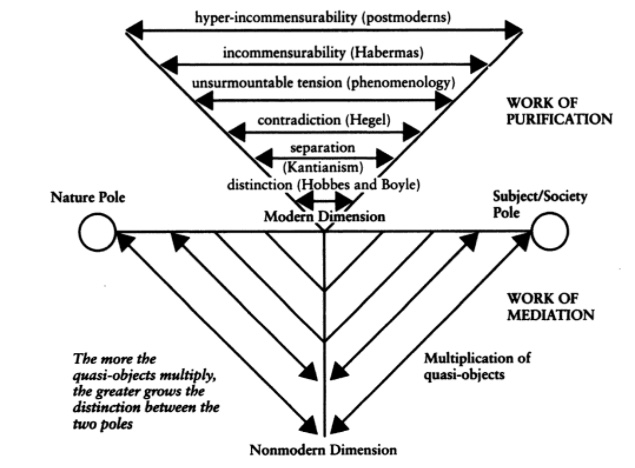
Figure 2: Dialectic (Hegel dontradiction) versus quasi-objects that multiple (P. 58 in Latour's WE HAVE NEVER BEEN MODERN)

Figure 3: Hegel/Marx Dialectic versus Quasi-Object in Latoruian Dialectic of Quasi-Object (p. 52 in Latour's WE HAVE NEVER BEEN MODERN)
Latour argues that up to this point (Plato-Hegel-Marx) there is an additional missing term (?, in figure above) is in the between and is below the dialectic, which is the 'quasi-object'. These quasi-objects as well as quasi-subjects, and quasi-standards multily in assembalges we call 'organizational systems.' Latour is critical of the Plato-Hegel-Marx-Heidegger dialectic, becasue it leaves out the quasi-objects, quasi-subjects, and quasi-standards.
""Dialectics literally beats around the bush. Quasi-objects are in between and below the two poles [Nature and Society in Figure above], at the very place awound withdualism and dialectics had turned endlessly without being able to come to terms with them. Quasi-objects are much more social, much more fabricated, much more collective than the 'hard' parts of nature, but they are in no way the arbitrary receptacles of a full-fledged society" (p. 55 WE HAVE NEVER BEEN MODERN).
The question posed in WE HAVE NEVER BEEN MODERN leads to the ANT theory where the material object plays an agential role in shaping social networks that a social constructivist theory of mapping relations between material and concept has left out.
See “Theory of the Quasi-Object” by Michael Serres
In Latour (1998/2005 Reassembling the Social) there are three kinds of quasi-SOMETHING.
1. Quasi-object - For example, a 'soccer ball' is a quasi object, obviously an object kicked about, but also an icon in the game of soccer, and the point of attention in the spatializing of the game itself. "Things, quasi-objects, and attachments are the real center of the social world, not the agent, person, member, or participant—nor is it society or its avatars" (p. 238).
2. Quasi-subject - "human members and context have been put into the background; what gets highlighted now are all the mediators whose proliferation generates, among many other entities, what could be called quasi-objects and quasi-subjects" (pp. 237-238). Another example is the undocumented immigrant, the DOCA student immigrant, now under discussion by Trump administration. In Europe, "If you doubt the ability of those humble paper techniques to generate quasi-subjects, try living in a large European city as an ‘undocumented alien’ or extricating yourself out of the FBI’s grip because of a misspelling of your name" (p. 208).
3. Quasi-standards "the circulation of quasi-standards allow anonymous and isolated agencies to slowly become, layer after layer, comparable and commensurable— which is surely a large part of what we mean by being human" (p. 230)." most coordination among agents is achieved through the dissemination of quasi-standards" (p. 229). Examples: ISO9000, ISO14000, the Reaccreditation standards of AACSB, SA7000 human relations standards, FASB accounting standards (See Boje, 2016 Tetranormalizing book).
Figure 4: 4 Wings of Tetranormalizing [quasi]- STANDARDS (Boje, 2016).
STORYTELLING-in-ACTION in ANT METHOD: :We now have quasiquantitative tools allowing us to follow in the same fashion rumors, opinions, facts, and fantasies. See Rogers, Information Politic on the Web. On the tracing of new quantum see Michel Callon (2001), ‘Les me´thodes d’analyse des grands nombres’" (footnote 275, p. 208).
“The phenomenologists have the impression that they gave gone further than Kant and Hegel and Marx, since they no longer attribute any essence either to pure subjects or to pure objects” (p. 58 WE HAVE NEVER BEEN MODERN).
Latour says that “Hege [dialectics]l brought the separation even more fully to life. He raised it to the level of a contradiction, pushed it to the limit and beyond, then made it the driving force of history… Dialectics further enlarges the abyss that separates the Object pole from the Subject pole, but since it surmounts and abolishes this abyss in the end, it imagines that it has gone beyond Kant!: (p. 57, bracketed addition, mine).
STEP 2 in your homework: To understand ANT, go to a construction site of a building, in its space, time, and materiality, actors and actants networking... be like the 'ant' and do ANT get at the storytelling going on that is relational, processual, and ontological.
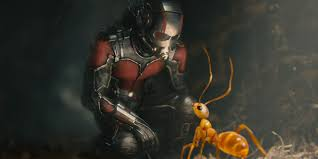
"... the acronym A.N.T. was perfectly fit for a blind, myopic, workaholic, trail-sniffing, and collective traveler. An ant writing for other ants, this fits my project very well!" (p. 9).
IT IS ABOUT BEING IN THE STORYTELLILNG as the ANT: "Every single interview, narrative, and commentary, no matter how trivial it may appear, will provide the analyst with a bewildering array of entities to account for the hows and whys of any course of action. Social scientists will fall asleep long before actors stop deluging them with data" (p. 47).
"This is why ANT has borrowed from narrative theories, not all of their arguments and jargon to be sure, but their freedom of movement" (p. 55).
What is ANT? "Using a slogan from ANT, you have ‘to follow the actors themselves’, that is try to catch up with their often wild innovations in order to learn from them what the collective existence has become in their hands, which methods they have elaborated to make it fit together, which accounts could best define the new associations that they have been forced to establish" (Latour, 1998/2005: p. 12).
ANT has human actors, and material 'actants' that matter. What is mattering of actants in ANT?
They combine open systems theory with ANT: "This interest for the object has nothing to do with a privilege given to ‘objective’ matter in opposition to ‘subjective’ language, symbols, values, or feelings. As we will see when absorbing the next source of uncertainty, the ‘matter’ of most self-proclaimed materialists does not have a great deal to do with the type of force, causality, efficacy, and obstinacy non-human actants possess in the world. ‘Matter’, we will soon realize, is a highly politicized interpretation of causality. In order to absorb the third source of uncertainty, we should be ready to inquire about the agency of all sorts of objects. But since objects have such poor and constricted roles in most of the social sciences, it’s very difficult to extend their original activity to other types of material like documents, writings, charts, files, paper clips, maps, organizational devices, in brief intellectual technologies" (Latour, 1998.2005: 76).
People doing construction of some-thing understand that ANT is about ontology of process, how the ACTORS and ACTANTS are NETWORKING to bring about metamorphosis:
"Usually, the great advantage of visiting construction sites is that they offer an ideal vantage point to witness the connections between humans and non-humans. Once visitors have their feet deep in the mud, they are easily struck by the spectacle of all the participants working hard at the time of their most radical metamorphosis" (p. 88).
EXPAND our understanding of what is agency? "... any study that gives non-humans a type of agency that is more open than the traditional natural causality—but more efficient than the symbolic one—can be part of our corpus" (p. 10).
MATERIAL AGENCY - WHAT IS DOING THE ACTION? and HOW AGENCY ACTS? And "Objects too Have Agency" (p. 63). "If you mention an agency, you have to provide the account of its action, and to do so you need to make more or less explicit which trials have produced which observable traces—which does not mean, of course, that you have to speak about it, speech being only one of the many behaviors able to generate an account and far from the most frequent"(p. 53).
STEP 3: Ask Ontological Questions by being their, researcher you Be the TRAVELER, in the spacetimemattering (Barad, 2007) of the construction and social networking.
"Sociologists of the social seem to glide like angels, transporting power and connections almost immaterially, while the ANT-scholar has to trudge like an ant, carrying the heavy gear in order to generate even the tiniest connection. At the end of this book, we will attempt to summarize what differentiates a good ANT account from a bad one—a crucial quality test—by asking three questions:
[1] have all the difficulties of traveling been recognized?
[2] Has the complete cost of the travel from one connection to the next been fully paid?
[3] Has the traveler not cheated by surreptitiously getting a ride from an already existing ‘social order’?
In the meantime, my advice is to pack as little as possible, don’t forget to pay your ticket, and prepare for delays" (p. 25, bracketed numbers and boldness, mine).
STEP 4: Be a STAR in analysis of five points of ANT STAR.
“An ‘actor’ in ANT is a semiotic definition – an actant – that is, something that acts or to which activity is granted by others” (Latour 1997, p 6).
Figure 5: Latour ANT STAR (figure by Boje), Source of image: Boje's course on Socio-economic consulting, Concepts in image, derived from Latour, 1998/2005: pp. 200-202.
1. NOT Isotopic (not same place) - " What is acting at the same moment in any place is coming from many other places, many distant materials, and many faraway actors" (p. 200).
2. NOT Synchronic (not same time) - Your computer and your desk is constructed of lots of different materials of different ages at different paces of decomposing. "Time is always folded. So the idea of any synchronic interaction where all the ingredients will have the same age and the same pace is meaningless—even for baboons. Action has always been carried on thanks to shifting the burden of connection to longer- or shorter-lasting entities" (p. 201)
3. NOT Synoptic (not same optic) - "Very few of the participants in a given course of action are simultaneously visible at any given point. The lecturer might believe she is center stage, but that does not mean that many others are not acting as well, only that there is no way to sum them up" (p. 201).
Figure 6: Image of TamaraLand drawn by one of Boje's Loyola Marymount Students in 1992. TamaraLand was worked out in Boje, D. M. 1995. "Stories of the Storytelling Organization: A Postmodern Analysis of Disney as 'Tamara-land.'" Academy of Management Journal. 38(4): 997-1035. Click for PDF version of article
In TamaraLand, people in an organization systems are not Isotopic, not synchronic, and not synoptic (not visible to each other, not in same room, at same time with all the others, and they follow story from room to room (Boje, 1995).
4. NOT Homogeneous (not same material agencies) - THIS IS ABOUT 'PROCESS', its shifts, successive material ingredients, signals, etc. and fits TamaraLand. "How many successive shifts in agencies should we have to detect if we wanted to move from the architect’s cabinet, fifteen years ago, to the lecture hall? When slides are projected on the screen, how many different successive ingredients are necessary when some writing on a keyboard becomes digitalized, then transformed again in an analogical signal before being retransformed in some sort of slower brain wave into the mind of half-asleep students? What is staggering in any given interaction is exactly the opposite of what sociologists with a tropism for ‘local sites’ find so great in finally reaching face-to-face encounters..." (p. 201).
5. NOT Isobaric (not same pressures) - THIS IS RELATIONAL delicacy of social fabric and the material actants interacting or as Barad (2007) in intra-activity. "Especially important are the different pressures exerted by mediators and intermediaries, the later adding, as we know, predictability to the setting, while the former might suddenly make it bifurcate in unexpected ways. At every point during the lecture, something could break, be it the microphone, the speaker, perhaps even the teacher. If any of the intermediaries mutates into a mediator, then the whole set up, no matter how solemn or controlled, may become unpredictable: (p. 201-202).
In sum, Latour has a RELATIONAL PROCESS ONTOLOGY, ANT actors and [material] actants intra-acting (in Baradian terms) to do space, time, materiality (or spacetimemattering in Baradian terms).
ANT ONTOLOGY
"To go from metaphysics to ontology is to raise again the question of what the real world is really like. As long as we remain in metaphysics, there is always the danger that deployment of the actors’ worlds will remain too easy because they could be taken as so many representations of what the world, in the singular, is like" (p. 117).
"It might be disappointing for the reader to realize that the grand questions of group formation, agency, metaphysics, and ontology that I have reviewed so far have to be tackled with no more grandiose resources than tiny notebooks to be kept during the fully artificial procedure of fieldwork and enquiries" (p. 135).
MORE ADVANCE TREATMENT OF ANT AND DIALECTIC SYMMETRY MEDIATION
Miettinen, R. (1999). The riddle of things: Activity theory and actor‐network theory as approaches to studying innovations. Mind, Culture, and Activity, 6(3), 170-195. Non-searchable pdf.
“it is fruitful to regard ANT as an elaboration and continuation of dialectical materialism and Marx’s historical anthropology” (Miettinen, p. 174, added N in ANT). It is about the dialectic of ‘mediated action’ (Vygotsky), the social mediation of activity in collective activity system that for Latour can transcend the duality poles of nature-realism and society (culture of social construction.
“ANT raises the challenge of studying reality as transitional in its becoming and as trajectories of creation. This idea of becoming and change is one of the central methodological ideals of dialectics as well” (p. 175). Marx historical materialism gave material conditions interpretation the Hegel’s spiritual/objectification of sensemaking. Marx drew on Feuerbach’s anthropological materialism, but switched the focus to analysis of human’s practical activity, which ANT uses to transcend dualistic oppositions between nature and society, subject and object, etc. “Man is a biological organism and a cultural being: (p. 175). John Law (and Callon) approach to ANT is relational materialism while Latour is assemblage of interactive relations. Both focus on fluid materialists, in an ontological choreography.Latour’s treatment of dialectics is a set of tricks arrows and circles (Latour, 1993: 57 WE HAVE NEVER BEEN MODERN, in Miettinen, p. 176). Later is critical of radical symmetry dialectic moves. For Latour dialectic mediate is a process, transporting energy from Nature to Society and vice versa. It harkens to Hegelian mediation dialectics. Latourseeks to avoid the reductionism of social constructivist method, by emphasising how nonhumans (actants) also act, which Marx does not. Marx makes work asymmetrical into distinct ontological spheres.
In heterogeneous assemblages of humans and material actants are relating (associating) and human actors and nonhuman actants are translating one another. Teaching operations, for example, are transfer to machines (distance education software and hardware), creating new associations.
“The central methodological principle of ANT is the principle of generalise symmetry” (Miettinen p. 182). Actors can be human or nonhuman, but the human ones are Machiavellian, oftentimes. Our networks of pedagogy are heterogeneous.
MORE LATOUR RESOURCES:
Latour, B. (1987). Science in action: How to follow scientists and engineers through society. Harvard university press. on line free pdf.
Latour, Bruno. On actor-network theory A few clarifications Source: Soziale Welt, 47. Jahrg., H. 4 (1996), pp. 369-381, on line free pdf.
Latour, B., (translated by Porter, C.). (1996). Aramis, or, The love of technology (Vol. 1996). Cambridge, MA: Harvard University Press.
Latour, B. (1999). On recalling ANT. The Sociological Review, 47(S1), 15-25. on line free pdf.
Latour, B. (2004). Politics of nature. Harvard University Press. on line free pdf.
Latour, B. (2010, February). Networks, societies, spheres: Reflections of an actor-network theorist. In International Seminar on Network Theory: Network Multidimensionality in the Digital Age. on line free pdf.
Latour, B. (1991 Freench/1993 English/2012 edition). We have never been modern. Harvard University Press. on line free pdf.
Latour, B. (2013). Biography of an inquiry: On a book about modes of existence. Social Studies of Science, 43(2), 287-301. on line free pdf.
ANT IMPACT IN ORGANIZATION SYSTEMS RESEARCH AND THEORY:
Contractor, N., Monge, P., & Leonardi, P. M. (2011). Network Theory| multidimensional networks and the dynamics of sociomateriality: bringing technology inside the network. International Journal of Communication, 5, 39. downloadable pdf at this link. Note: this is a good connector article to our RPO chapter on Karen Barad, which comes up next.
"One important outcome emerging from linking ANT and system theory is a symmetrical, mutually dependent relationship "between the social construction of spatiality and spatial construction of sociality" (p. 5). " The proposal of this paper is to argue using the tools of system theory, and this means considering spatial systems as systems in the environment of social systems. To get there it is helpful to take into account some ideas of actor network theory that are concerned with the understanding of objects and spaces" (p. 6)
"If one communication is not joined to another communication the system ceases temporarily to exist. This is true even in the case if one member of the family is in the kitchen and the other is in the bedroom. Consequently, it is possible to describe family exclusively within the context of a social system. But this is somehow unsatisfactory, since a family remains a family beyond the systems’ status, for example as a legal institution. A further important property is the shared home (it certainly could be split to two or more homes temporarily as shown below). It makes sense to regard the shared home as a spatial system which is structurally linked to the social system of the family" (P. 6).
Geels, F. W. (2004). From sectoral systems of innovation to socio-technical systems: Insights about dynamics and change from sociology and institutional theory. Research policy, 33(6), 897-920.
Hawe, P., Shiell, A., & Riley, T. (2009). Theorising interventions as events in systems. American journal of community psychology, 43(3-4), 267-276. Available free at Research Gate (may need account).
"This takes community intervention into the realm of actor network theory, that is, the idea that new concepts start to get tied to material things through their use by actors. These material objects become active in the way that meaning is transferred through the network (Latour 2005)" (p. 271).
Koch, A. (2005). Autopoietic spatial systems: the significance of actor network theory and system theory for the development of a system theoretical approach of space. Social Geography, 1(1), 5. on line free pdf.
Johnston, R. B. (2001). Situated action, structuration and actor-network theory: an integrative theoretical perspective. ECIS 2001 Proceedings, 73. on line free pdf.
Puts ANT into a sociotechnical systems connection."... realized the need for a socio-technical account of these problems, at least by the early 1970s (Trist 1982). The early socio-technical systems theory notion of joint optimization of the social and technical proved too static for the task" (p. 512). Note Savall, one of our RPO chapters, reached same conclusion in 1975 and developed his socioeconomic approach to systems change
Law, J. 1999. After ANT: complexity, naming and topology. In: Law, J. & Hassard, J. (eds) Actor-Network Theory and after. England. Oxford: Blackwell Publisher.
Lee, N., & Hassard, J. (1999). Organization unbound: Actor-network theory, research strategy and institutional flexibility. Organization, 6(3), 391-404.
Leonardi, P. M. (2012). Materiality, sociomateriality, and socio-technical systems: what do these terms mean? How are they related? Do we need them?.
Mouritsen, J., Mahama, H., & Chua, W. F. (2010). 12 Actor-Network Theory and the Study of Inter-Organisational Network-Relations. Accounting in networks, 7, 292.
Noe, E., & Alroe, H. F. (2006). Combining Luhmann and actor-network theory to see farm enterprises as self-organizing systems. Cybernetics & Human Knowing, 13(1), 34-48. on line free pdf.
They combine: "the actor theory path, ending in actor-network theory (ANT), and the systems theory path, ending up in Luhmann’s theory of selfreferential social systems" (p. 2)."o Farms are heterogeneous systems, that is, they are composed of many different kinds of entities such as soil, machinery, animals, persons, knowledge, regulations, enterprises, etc."
"o Farms involve fundamentally different kinds of relations, such as physical/nonsemiotic, biological/semiotic and intellectual/self-reflexive relations" (p. 3).
"I simply want to note that actor-network theory may be understood as a semiotics of materiality. It takes the semiotic insight, that of the relationality of entities, the notion that they are produced in relations, and applies this ruthlessly to all materials - and not simply to those that are linguistic" (Law 1999, p 4).
"Autopoietic systems are systems that are defined as unities as networks of production of components that recursively, through their interactions, generate and realize the network that produces them and constitute, in the space in which they exist, the boundaries of the network as components that participate in the realization of the network” (Luhmann 1990, p 3). Luhmann, N. 1990. Essays on Self-reference. USA. Colombia University Press, New York.
"The concept of actant can be further analysed in Peircean terms, into the representamen, the sign as determined by the object, and the interpretant, the sign as determining some subject. Furthermore Peirce distinguishes between the immediate object, which is the object as referred to, within the sign, and the mediate or dynamical object, which is the independent object that is pointed or hinted at, outside the sign (Peirce 1998, p. 477ff)" (in Noe & Alroe, 2006: 11, footnote #2):
Pollack, J., Costello, K., & Sankaran, S. (2013). Applying Actor–Network Theory as a sensemaking framework for complex organisational change programs. International Journal of Project Management, 31(8), 1118-1128. Available at Research Gate (may need account first).
"An ANT study should trace a network of association between actors, possibly in narrative form, describing the interactions that contribute to the formation and stabilisation of actor-networks. It should describe a case through the terminology and concepts of the actors, while avoiding resorting to external generalisations as a way of explaining action, or hidden conceptual frameworks that purport to reveal knowledge that is unavailable to those in the situation" (pp. 5-6, in online version).
Tatnall, A. (2003). Actor-network theory as a socio-technical approach to information systems research. In Socio-technical and human cognition elements of information systems (pp. 266-283). Igi Global.
Young, D., Borland, R., & Coghill, K. (2012). Changing the tobacco use management system: blending systems thinking with actor–network theory. Review of Policy Research, 29(2), 251-279. Available at Research Gate.
"ANT focuses the contest for change on heterogeneous networks of human and nonhuman actors that must be constructed through a process of defining and defending models of change, building alliances, gaining public acceptance, and finally achieving institutional acceptance of the reform (or of some compromise)" (p. 251).
